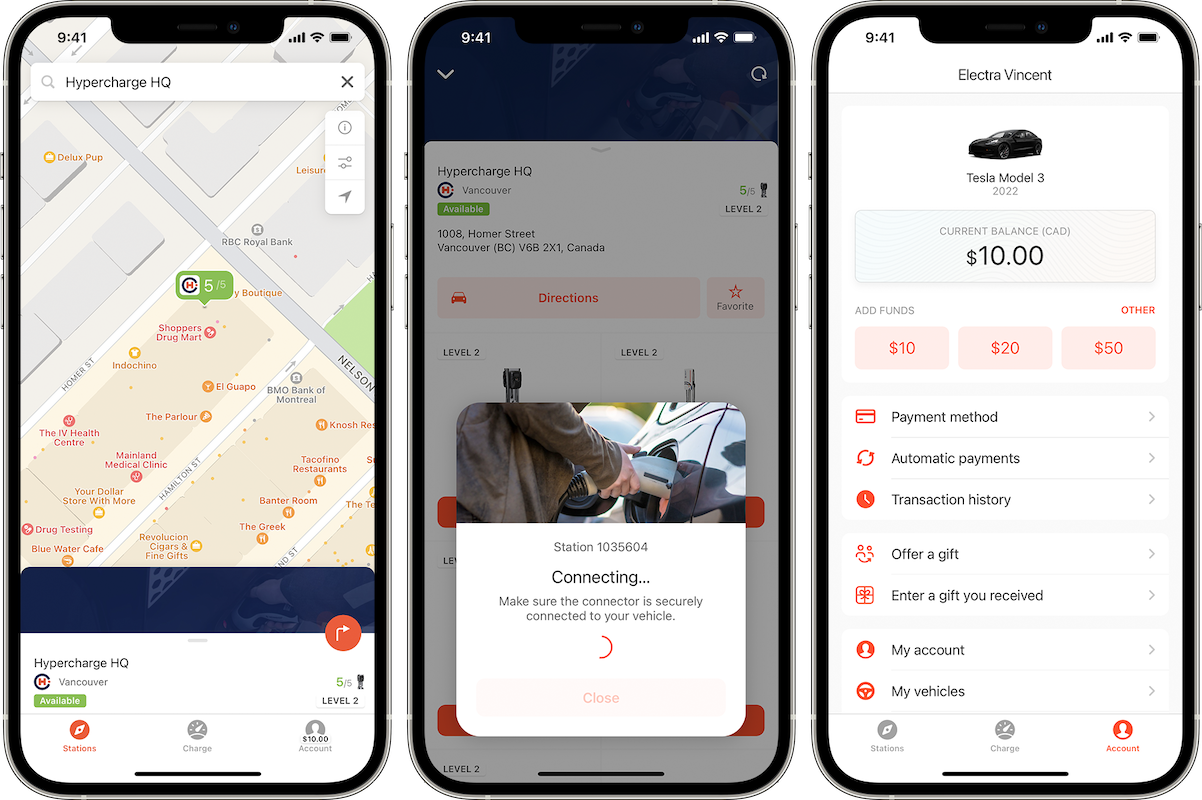Our Batteries 101 post was a primer on electric vehicle batteries: their size, charging speeds, and how far they’ll take you before you need to recharge. Today, we’re looking at the cost of charging EV batteries, using three popular vehicles as examples.
We’ll begin by getting familiar with the most important factors that contribute to your bill, then show you how to estimate charging costs based on the charger, your vehicle’s technical specifications, and the average hourly rate at Hypercharge’s Level 2 stations.
Note: Our focus is pay-per-minute charging, the only current form of billing when accessing chargers at workplaces, apartment and condominium buildings, and public charging stations. Drivers who have a dedicated charger at home pay through their electricity bill, at the kilowatt-hour (kWh) rate set by the provincial or state government plus taxes.

Charger Type
As explained in our Batteries 101 post, the amount of energy an EV battery can store is measured in kilowatt-hours. The 2022 Hyundai Kona, for example, has a battery capacity of 64 kWh, which will take you 415 kilometres on a full charge. The larger a battery’s capacity, the longer it may take to charge it, though this can be mitigated by the type of charger used.
A Level 3 charging station can fully charge the Hyundai Kona from 0-100% in just over an hour, whereas a Level 2 charger would take longer. Because Level 3 charging is expensive and can reduce the lifespan of a battery with regular use, most drivers stick with Level 2 stations for the bulk of their charging, which is why we use Level 2 chargers in our price calculations below.
Billing Method
Pay-per-use charging is billed by the minute in Canada. Elsewhere, drivers can pay per kilowatt-hour, something Measurement Canada will allow in the future. Many experts believe per-kWh billing is fairer because it’s based on the amount of energy delivered, rather than the time it takes to deliver it, which can be impacted by a variety of factors (some of which we cover here).
Charging prices at most Hypercharge stations are set by the station operators, however we’ve calculated an average price of $1 CAD per 60 minutes of charging at Level 2 chargers. Longer charging times lead to bigger bills, so let’s examine two key influences on charging duration.
Output Rate
A charger’s amperage (amps) is the maximum amount of electrical current it can supply. When combined with the voltage of the power source, you get the charger’s output rate, which is measured in kilowatts (kW). This is not to be confused with kilowatt-hours (kWh), which measures the amount of energy stored inside the battery. In other words, kW indicates the flow of energy from the charger to the battery, while kWh tells us how much energy has been delivered.
That’s a lot of measurements to swallow, but figuring out how quickly a charger can add power to a battery couldn’t be easier. For example, Hypercharge’s popular JNT-EVC11 Level 2 AC Charger has a maximum output of 7.6 kW. To calculate the kilowatt-hours it will provide at this rate, simply multiply the kilowatts by one hour: 7.6 kW x 1 hour = 7.6 kWh. This means that if you plug a vehicle into the JNT-EVC11 for one hour, the charger will theoretically (real world usage may vary depending on environment and other factors) add up to 7.6 kWh of energy to the battery; if you plug it in for two hours, it will add up to 15.2 kWh, and so on.
Charging Capacity
We must also consider the vehicle’s capacity to take in power. This is known as the “charging capacity” or “power acceptance rate,” and it’s determined by the on-board charger that sends the electrical current to the battery. No matter how fast a charging station is, it can’t provide power faster than the vehicle can accept it and vice versa.
For example, the 2022 Tesla Model 3 RWD has a charger capacity of 11.5 kW—higher than the output rate of most Level 2 charging stations, which hovers around 7 kW. To make the most of the charging capacity, a better choice of station would be Hypercharge’s powerful JNT-EVC10 Level 2 AC Charger, which has a maximum output of 11.5 kW.
Putting It Together
To calculate the time it will take to achieve a full charge, divide the vehicle’s battery capacity by the charging station’s output rate or the vehicle’s charger capacity, whichever is lower.
For this example, we’ll use Hypercharge’s JNT-EVC10 Level 2 AC Charger again and the 2022 Chevrolet Bolt, which has a battery capacity of 65 kWh. The charger’s maximum output and the Bolt’s charger capacity are the same: 11.5 kW.
First, as we did above, convert the kilowatts to kilowatt-hours by multiplying by one hour:
11.5 kW x 1 hour = 11.5 kWh delivered per hour of charging
Divide the battery’s capacity by the kilowatt-hours:
65 kWh ÷ 11.5 kWh = 5.7 hours total charging time
Finally, to determine cost, multiply the total charging time by an average price per hour:
5.7 hours total charging x $1 per hour = $5.70 per full battery.
Here’s how our three sample EVs stack up against one another using Hypercharge’s JNT-EVC10 AC Charger:
|
Vehicle |
Battery Capacity |
Charging Capacity |
Charging Time |
@ $1 per hour |
|
2022 Chevrolet Bolt |
65 kWh |
11.5 kW |
5.7 hours |
$5.70 |
|
2022 Hyundai Kona |
64 kWh |
7.2 kW |
8.9 hours |
$8.90 |
|
Tesla Model 3 RWD |
60 kWh |
11.5 kW |
5.2 hours |
$5.20 |
Find Hypercharge Charging Stations
To find a Hypercharge charger near you, visit our Drivers page or download our industry-leading mobile app. Through the app, you can initiate, manage, and pay for charging, keep track of your transaction history, and monitor your average cost of charging per session.
